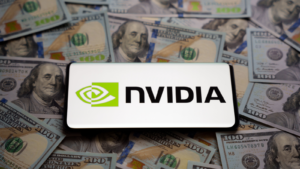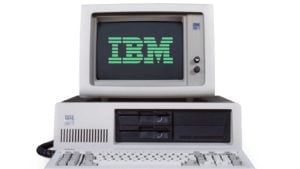
When you think about blue chip stocks to buy, you’re thinking about some of the very best stocks in the market. And those are names that should always be in your portfolio.
Blue chip stocks have a well-deserved reputation because they have stable earnings, great reputations, and solid financials. They always represent companies with a track record of success in their industries.
I like investing in blue chip stocks because I know that my money is with companies that can withstand economic downturns and are less volatile than a smaller, less stable firm. Blue chip stocks to buy always have a strong potential for long-term growth as well.
When looking for blue chip stocks to buy, I like to use the Portfolio Grader to identify those that are outperforming the market. The Portfolio Grader ranks stocks based on earnings performance, growth, analyst sentiment and momentum. It’s a great tool to quickly pick out the best of the best.
These blue chip stocks could be a great anchor for any portfolio in Q2.
Nvidia (NVDA)

I’m not sure that Nvidia (NASDAQ:NVDA) would have been classified as a blue chip stock just a year or two ago. The maker of graphics processing units was long one of the better known semiconductor stocks, but that was before semiconductors were in the mainstream.
Now it’s all changed. Nvidia’s stock jumped over 200% in the last year, and its earnings leapt sixfold.
Its products have roughly a 90% market share in powering generative artificial intelligence applications, making Nvidia one of the most sought-after companies in the world.
Now, Nvidia has a market capitalization of more than $2.2 trillion, making it the third biggest company in the world by market cap. It’s unquestionably a blue chip stock.
NVDA’s also off to a great start in 2024, up more than 80%. It gets an “A” rating in the Portfolio Grader.
Meta Platforms (META)

By contrast, Meta Platforms (NASDAQ:META) has been in the public eye for a long time now.
The company formerly known as Facebook was even the subject of a major motion picture back in 2010, with Hollywood stars Jesse Eisenberg, Justin Timberlake, and Andrew Garfield taking leading roles. You don’t get more mainstream than that.
Nearly half the world’s population uses Meta’s platforms on a monthly basis. Facebook, Instagram, Threads and WhatsApp are important sources of news, information and entertainment.
Meta Platforms generated $40.1 billion in revenue in the fourth quarter of 2023, up 25% from the previous year. Its income of $14 billion and $5.33 per share was a huge improvement from Q4 2022, when it earned $4.6 billion and $1.76 per share.
Today’s Meta Platforms is a leaner, more profitable company. It reduced its head count by 22% in the last year, and that makes it a better investment. META stock is up 37% this year and gets an “A” rating in the Portfolio Grader.
Walmart (WMT)

Walmart (NYSE:WMT) is simply the biggest retailer in the world. With over 10,800 locations, the Arkansas-based company has a mammoth footprint that dominates its markets by selling everything from food to televisions, shoes, clothing and household furnishings.
I also like that Walmart is serious about its e-commerce efforts. Not willing to cede the landscape to Amazon (NASDAQ:AMZN), Walmart’s e-commerce division grew by 23% in 2023, topping $100 billion in sales.
Walmart’s subscription plan offers free deliveries and discounts, giving it a valuable stable income stream that reached $3.1 billion in 2023, up from $2.6 billion a year ago.
WMT stock is up 14% in 2024 and gets an “A” rating in the Portfolio Grader.
International Business Machines (IBM)

Known as Big Blue, International Business Machines (NYSE:IBM) is one of the world’s best-known and significant computing companies.
For generations, it has been at the forefront of technology, including developing punch-card tabulators in the early 20th century to helping to put men on the moon in the 1960s.
IBM supplies the computing power that makes the world run smoother . More than 90% of banks use IBM products, and over 80% of all travel reservations are processed through IBM products.
As many as 90% of all credit card transactions go through IBM mainframe computers.
IBM is eyeing the future as a leading developer of quantum computing, a technology that will continue to change and shape the world as we know it.
IBM stock is up 16% this year and gets an “A” rating in the Portfolio Grader.
Netflix (NFLX)

Netflix (NASDAQ:NFLX) is a blue chip stock because it is the most recognizable and successful streaming service, and it didn’t get there by accident.
Netflix got its start in the days of home video rental stores, disrupting the industry by delivering rented videos and games by mail rather than having customers go to a brick-and-mortar store. It was a brilliant strategy.
Then Netflix contributed to disrupt the cable industry through its streaming service. Netflix ventured into original programming with shows like Stranger Things, Bridgerton and Squid Game.
According to the company’s six-month engagement report, consumers watched Netflix programming for 100 billion hours collectively in the first six months of 2023.
Netflix is a powerhouse that is managing to keep the growth coming. Revenue in the fourth quarter was $8.83 billion, up from $7.85 billion a year ago.
Netflix forecasts Q1 revenue of $9.2 billion, which would be a huge jump from the $8.1 billion it brought in during the first quarter of 2023.
NFLX stock is up 24% in 2024 and gets an “A” rating in the Portfolio Grader.
Chipotle Mexican Grill (CMG)

Chipotle Mexican Grill (NYSE:CMG) is a blue chip stock that’s disrupted the restaurant industry much as Netflix disrupted video rental stores.
The fast-casual restaurant showed consumers and competitors alike that there’s more to a fast-food restaurant than burgers and chicken sandwiches.
Chipotle now has over 3,400 locations offering burritos and Tex-Mex fare, famously including fresh foods cooked in-house with no artificial ingredients or flavors.
Interestingly, Chipotle owns all of its restaurants rather than using the franchise model that many fast-food restaurant companies favor.
Chipotle also made news this year when it announced a 50-for-1 stock split. It’s one of the largest ever on the New York Stock Exchange and is slated for June.
The stock split will make CMG stock more accessible to retail traders, including those who like to dabble in options.
Chipotle posted earnings of $2.5 billion for the fourth quarter, up 15.4% from a year ago, and comparable restaurant sales that improved by 8.4%.
CMG stock is up 27% in 2024 and gets an “A” rating in the Portfolio Grader.
General Electric (GE)

General Electric (NYSE:GE) is a comeback story of its own.
GE got a little too diversified. It had its fingers into health care, aviation and financial services and then took a huge beating during the collapse of the subprime mortgage industry.
But GE bounced back. It dumped its light bulb and signature appliance business. It dropped NBC Universal.
Now, GE is leaner and more profitable. It has a focus on aerospace, renewable energy solutions, wind and gas turbines, and commercial and defense aircraft engines.
It already spun off GE HealthCare Technologies (NASDAQ:GEHC) into its own company. On April 2, GE plans to spin off the energy solutions and turbine business as GE Vernova, with the ticker GEV.
What’s left will be called The remaining company will be called GE Aerospace, but will maintain the GE ticker.
Management hopes the new structure will help GE remain focused on its primary mission. Gone are the days where GE dabbles in a little bit of everything.
GE stock is up 37% in 2024 and gets an “A” rating in the Portfolio Grader.
On the date of publication, Louis Navellier and InvestorPlace Research Staff member primarily responsible for this article had long positions in NVDA. They did not have (either directly or indirectly) any other positions in the securities mentioned in this article.






